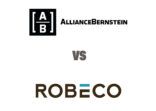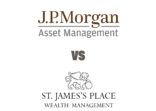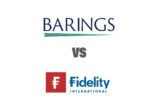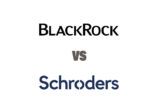However, the first quarter proved to be the weakest since 2012 for the earnings per share of S&P-listed companies. The strong dollar and low oil prices dragged down earnings, according to JP Morgan Asset Management.
While the firm expects EPS growth to rebound later this year, it warned that investors should lower their return expectations to single-digits.
Separately, the US Federal Reserve released the minutes of its April policy meeting, which commentators say is in line with market expectations that the interest rate is not likely to be raised in June.
Weak economic indicators released this week have reinforced views that the rate hike is likely to be delayed until after June.
Against this backdrop, Fund Selector Asia takes a look at the Fidelity America Fund and the Janus US Twenty Fund.
The Luxembourg-domiciled Fidelity fund is much larger in size and also has a comparatively longer tenure than the Ireland-based Janus fund.
The Fidelity fund has been in inception since 1990 and had $8.1bn in assets under management on 31 March. The Janus vehicle has been running since 1998 and had $368m in AUM.
The Fidelity fund received the Platinum award at the inaugural FSA Awards in the Singapore fund universe, and it won a gold award in the Hong Kong universe.
The Fidelity fund seeks to invest in significantly undervalued or mispriced companies, which have been underperforming for a period of time, but have the potential to recover over the long-term.
The Janus fund, by comparison, adopts a high-conviction strategy and invests in large-cap growth companies.
Accordingly, the portfolio construction differs, with the Janus fund holding a more concentrated portfolio than the Fidelity fund.
Luke Ng, vice president at FE Advisory Asia, provides a comparative analysis.
Investment strategy review
Angel Agudo, manager of the Fidelity fund, builds the portfolio using a combination of quantitative screening, sell-side and in-house research, and his own analysis, Ng said.
Agudo aims to invest in companies that are significantly undervalued, either because they are out of favor or little value is given to their recovery potential.
“Through analysis of a company’s business model, competitive environment and management, he identifies stocks with limited downside potential but with strong relative upside.”
He sets upside and downside price targets for each holding in the portfolio. This is monitored on an on-going basis and positions are adjusted based on these price targets, Ng said.
The Fidelity fund tends to invest in 50-60 stocks and the average investment horizon of a stock is 18-to-24 months.
In regards to the Janus fund, Marc Pinto, the portfolio manager, intends to invest in growth companies that have a combination of a strong competitive edge, pricing power and attractive valuation.
Compared to the Fidelity fund, the Janus fund holds a very concentrated portfolio of 20-to-30 stocks and the average investment horizon of a stock is about 36 months.
“The Janus fund portfolio is more concentrated and the underlying holdings are characterised by higher growth.”
“The Fidelity fund has holdings in stocks that have likely bottomed-out, and are often trading at a very low valuation at the time of purchase.”
Despite different strategies, both funds are biased toward large-cap companies and are overweight the healthcare and technology sectors.
Some deviations are observed in the allocation toward the financial and consumer discretionary sectors. The Fidelity fund is underweight consumer discretionary sector whereas the Janus fund is overweight.
The Fidelity fund is underweight financial companies whereas the Janus fund is overweight this sector.
A snapshot of portfolio allocation:

Performance review

The Fidelity fund benchmarks its performance against the S&P 500 index. The Janus fund uses both the S&P 500 and the Russell 1000 Growth index as benchmarks.
Both funds have outperformed the S&P 500 over various time periods to 30 April.
The Fidelity fund outperformed the Janus fund over three- and five-year periods, as seen in the table below.
But the Janus fund outperformed the Fidelity fund over the short-term (six-months and one-year) and 10-year period.
Performance over various periods until 30 April:


As mentioned earlier, the S&P 500 index has been reaching record highs in 2015.
However, Ng noted that both Angel Agudo (the Fidelity fund manager) and Marc Pinto (the Janus fund manager) outperformed the S&P 500 since they took over management responsibility in June 2014 and May 2013, respectively.
A look at calendar year returns:

Due to its highly-concentrated growth portfolio, the Janus fund tends to be more volatile than its respective benchmark indices and the Fidelity fund, Ng said.
“The Fidelity fund offers better downside protection as the underlying holdings are often significantly undervalued.”
This was observed in 2011, when the returns of the Fidelity fund declined 3.7% while the downside was more for the Janus fund (-8.9%).
Manager review

Angel Agudo took charge of the Fidelity fund in June last year after Adrian Brass left the firm.
Agudo has been with the firm since 2005.
Apart from the America fund, he has been managing the Fidelity American Special Situations product since December 2012. He was also manager on the Fidelity Global Industrials fund from January 2011 to February 2012, according to FE Analytics.
“He has a relatively short track record for the Fidelity America fund. But he has been delivering outstanding performance for the American Special Situations fund against the S&P500 index,” Ng noted.

The Janus fund has been managed by Marc Pinto since May 2013.
“If you look at the Janus fund’s performance from May 2013 (since Pinto took over the manager role) until 30 April, it has significantly outperformed the sector average, as well as the Fidelity fund over the period (as of Apr 2015).”
The Janus fund registered a 40.3% return for the period 31 May 2013 to 30 April, outperforming the Fidelity fund, which posted a 36.8% return and also the Singapore universe of North America funds (28%), Ng pointed out.
Pinto is also manager of other funds such as the Janus Large Cap Growth and the Janus Opportunistic Growth and Focused Equity strategies, while he is a co-manager on the Janus Balanced and Growth & Income fund.
He has been with the firm since September 1994.
Fees

The Fidelity fund charges annual management fees of 1.5% for its retail share class, higher than the 1.25% levied by the Janus fund.
The total expense ratio (TER) or on-going charges for the Fidelity fund was 1.89% for share class A for the year ended 30 April. This was lower than the Janus fund’s TER of 2.21% for the year ended December.
“The difference could be due to the larger fund size of the Fidelity fund,” Ng said.
Conclusion

The Fidelity fund is rated by FE as a 5 Crown product and the Janus vehicle gets 3 Crowns. The FE crown rating ranks funds based on alpha, consistency and volatility.
As mentioned earlier, the Fidelity fund has delivered better returns in the medium-term and was generally less volatile than the Janus product.
The Fidelity fund, due to its strong bias toward undervalued stocks, should offer comparatively better downside protection, Ng said.
“The Janus fund holds a concentrated portfolio with growth stocks, which tends to be more volatile, but it should fare better in a rising market,” he added.
















